Yeohelmetguy
Well-known member
For this post I am showcasing two 1871 pattern trooper or other ranks dragoon helmets from my collection. The first helmet s a helmet worn by the 2nd Dragoon Guards (Queen’s Bay’s) and the second helmet is to the 3rd (Prince of Wales’s) Dragoon Guards.
For these Forum members not overly familiar with the various regiments of Dragoons and Dragoon Guards that made up part of the cavalry arm in the British Army, there were three regiments of Dragoons and seven regiments of Dragoons Guards. All the regiments of Dragoons and Dragoon Guards wore a metal dragoon style helmet with the exception of the 2nd Dragoons (The Royal Scots Greys) who wore a grenadier style busby. The two other regiments of dragoons wore white/silver metal helmets, and the seven regiments of dragoon guards wore brass/gilt helmets. Originally, when all dragoon regiments (except the 2nd Dragoons) when they adopted the 1847 or Albert pattern helmet, wore a black plume to their helmets. Army Regulations of 1855 specified specific color plumes for the various regiments but if appears the new 1857 Army Regulations codified the plume colors which were taken into ware around the end of the Crimean War as follows: 1st Royal Dragoons, black; 6th Inniskilling Dragoons, white; and the dragoon guards, 1st Kings Dragoon Guards, red; 2nd Dragoon Guards (The Queen’s Bays), black; 3rd (Prince of Wales’s) Dragoon Guards, black over red; 4th Royal Irish Dragoon Guards, white; 5th (Princess Charlotte of Wales’s) Dragoon Guards, white over red; 6th Dragoon Guards (The Carabiniers), white; 7th (The Princess Royals) Dragoon Guards, black over white. These plume colors were displayed on the later 1871 pattern helmets too, as shown in the two examples of troopers' helmets below, again, the first helmet to the 2nd Dragoon Guards (Queen’s Bays) and the second to the 3rd (Princes of Wales’s) Dragoon Guards. You will be able to compare these two other ranks helmets to an officer’s 1871 pattern helmet to the 6th Dragoon Guards (The Carabiniers) also from my collection if you refer back to my post #3 here on the Forum. I also have an officer's helmet to the 6th Inniskilling Dragoons and a 5th (Princes Charlotte of Wales’s) Dragoon Guards officer’s helmet that I will showcase in a separate post at a later date that you will be able to compare to these two trooper's helmets.
The 2nd Dragoon Guards (Queen’s Bay’s) was formed as the Earl of Peterborough’s Regiment of Horse in June 1685 by merging four of the independent troops of horse raised to fight for King James II against the Monmouth Rebellion. These had been raised in Hounslow, Edgware, London and Yorkshire respectively. Three years later, the new unit went over to James's rival William III, fighting for him at the Battles of the Boyne (1690) and Augh Rim (1691) in Ireland. At the latter, its charge alongside the Royal Horse Guards to win the battle. After a short period opposing highwaymen in what is now south London, the regiment then spent 1694 to 1698 fighting for William in the Low Countries. During the War of Spanish Succession (1701-14), it fought in Portugal and Spain, charging at Almanza (1707) and Almenar (1710), but being overwhelmed and captured by superior forces at Brihuega (1710). Soon after, it returned to Britain via a prisoner exchange. The regiment fought against both the 1715 and 1745 Jacobite Rebellion, becoming dragoon guards shortly after the latter campaign. This period also saw it renamed 'The Princess of Wales's' and then 'The Queen's Own' after Caroline, the wife of King George II. In 1751, the unit was retitled again as the 2nd (The Queen's) Regiment of Dragoon Guards. During the Seven Years War (1756-63), it fought at Corbach (1760), Warburg (1760) and Wilhelmsthal (1762), before returning home to put down riots in England in 1763. In 1767, the regiment's custom of only riding bay-colored horses was recognized in its title, becoming the 2nd Dragoon Guards (Queen's Bays). It fought in Germany, the Low Countries and northern France during the first three years of the French Revolutionary Wars (1793-1802). This included the Battle of Valenciennes (1793) and service as infantry at the siege of Dunkirk in 1793, where the ground was too marshy to operate as cavalry. The regiment returned home at the end of 1795.
It returned to the Continent in the aftermath of Waterloo (1815), joining the Army of Occupation for three years. Following a long period of policing and garrison duties at home, the unit next deployed to India after the out-break of mutiny there in 1857. It went on to help capture Lucknow in 1858. It then spent most of the remainder of the 19th century garrisoning India or on home service. It also deployed to the Boer War (1899-1902) in 1901, taking part in the anti-guerrilla operations there, and sustaining heavy losses at Leeuwkop in 1902.
The outbreak of the First World War (1914-18) saw it deploy to the Western Front with the 1st Cavalry Division. It fought in both a mounted and infantry role in many engagements, including the Retreat From Mons, (1914), Le Cateau (1914), the Marne (1914), Ypres (1914), the Somme (1916), Arras (1917), Cambrai (1917) and the Scarpe (1918).
The regiment was renamed the Queen's Bays (2nd Dragoon Guards) in 1921 and spent the inter-war period in Egypt, India and England, where it mechanized with light tanks in 1937. Two years later, it joined the Royal Armored Corps.
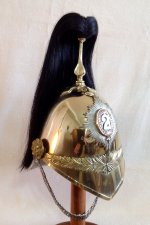
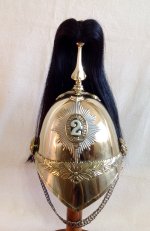
The 3rd (Prince of Wales’s) Dragoon Guards was formed in 1685 when Thomas Hickman-Windsor, 1st Earl of Plymouth, formed a troop of cuirassiers to help suppress the Duke of Monmouth's revolt against King James II. Later that year, this troop was merged with five others to form a regiment, initially ranked as the 4th Horse. After James's fall, the regiment fought for his rival and successor, King William III. It served at Steenkirk (1692), Landen (1693) and Namur (1695) during the Nine Years War (1688-1697).
During the War of the Spanish Succession (1701-14), the regiment fought at Schellenberg (1704), Blenheim (1704), Ramillies (1706), Oudenarde (1708) and Malplaquet (1709). It spent the next 30 years mainly on peacetime duties, although it did help suppress the 1715 Jacobite Rebellion. In 1746, it was converted into a dragoon guards' regiment, before being renamed the 3rd Regiment of Dragoon Guards in 1751. During the Seven Years War (1756-63), it fought in Germany at Minden (1759), Corbach (1760), Warburg (1760) and Vellingshausen (1761). In 1765, it took on the title of the Prince of Wales, who would later become the Prince Regent and then King George IV. In 1793, the regiment joined the Flanders campaign against Revolutionary France. It saw action at the Siege of Dunkirk (1793), Cantilon (1794), Villers en Cauchies (1794), Beaumont (1794) and Willems (1794).
From 1809 to the end of the Napoleonic Wars (1803-15), it was in the Peninsula, serving at Talavera (1809), Busaco (1810), Torres Vedras (1810), Albuera (1811), Badajoz (1811), Ciudad Rodrigo (1812), Salamanca (1812), Burgos (1812) and Vitoria (1813). The regiment then spent most of the 19th century on home service. It charged rioters in Bristol in 1831 and was kept in Ireland on garrison duties during the Crimean War (1854-56). However, it did deploy to India from 1857 to 1868, and from 1884 to 1895. In 1868, it was also the only British cavalry unit to participate in the Abyssinian Expedition (1867-68).
The regiment was deployed to the Boer War (1899-1902) from 1901 to 1902, taking part in the anti-guerrilla operations in the Transvaal and Orange Free State. It then spent time in Ireland, England and Egypt on garrison duties. The 3rd Dragoon Guards arrived on the Western Front in October 1914. It remained there for the entire First World War (1914-18), taking part in many engagements including the first and second battles of Ypres (1914 and 1915), Loos (1915), Arras (1917), Cambrai (1917), St Quentin (1918) and Amiens (1918). In 1919, the regiment began a two-year deployment to Ireland during the Irish War of Independence (1919-21). In 1922, the regiment was merged with the 6th Dragoon Guards (Carabiniers). Both units were in India at the time. The new force was initially known as the 3rd/6th Dragoon Guards, but six years later it adopted elements of both predecessor regiment's names, becoming the 3rd Carabiniers (Prince of Wales’s Dragoon Guards).
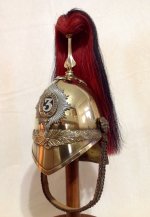
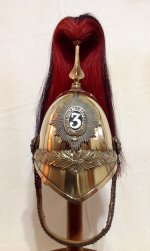
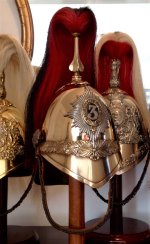
Below are a couple of images of British Army dragoons waring "full dress."
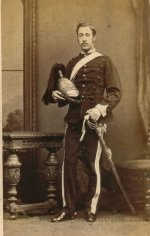
2nd West Yorkshire Dragoons
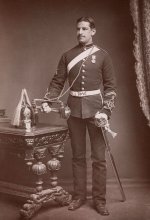
Trumpeter, 4th Royal Irish Dragoon Guards
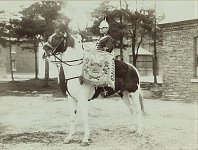
Kettledrummer, 3rd (Prince of Wales's) Dragoon Guards
I hope this post is interesting and informative and provides the Forum members an increased interest and understanding of British Army dragoon helmets.
Cheers,
David
For these Forum members not overly familiar with the various regiments of Dragoons and Dragoon Guards that made up part of the cavalry arm in the British Army, there were three regiments of Dragoons and seven regiments of Dragoons Guards. All the regiments of Dragoons and Dragoon Guards wore a metal dragoon style helmet with the exception of the 2nd Dragoons (The Royal Scots Greys) who wore a grenadier style busby. The two other regiments of dragoons wore white/silver metal helmets, and the seven regiments of dragoon guards wore brass/gilt helmets. Originally, when all dragoon regiments (except the 2nd Dragoons) when they adopted the 1847 or Albert pattern helmet, wore a black plume to their helmets. Army Regulations of 1855 specified specific color plumes for the various regiments but if appears the new 1857 Army Regulations codified the plume colors which were taken into ware around the end of the Crimean War as follows: 1st Royal Dragoons, black; 6th Inniskilling Dragoons, white; and the dragoon guards, 1st Kings Dragoon Guards, red; 2nd Dragoon Guards (The Queen’s Bays), black; 3rd (Prince of Wales’s) Dragoon Guards, black over red; 4th Royal Irish Dragoon Guards, white; 5th (Princess Charlotte of Wales’s) Dragoon Guards, white over red; 6th Dragoon Guards (The Carabiniers), white; 7th (The Princess Royals) Dragoon Guards, black over white. These plume colors were displayed on the later 1871 pattern helmets too, as shown in the two examples of troopers' helmets below, again, the first helmet to the 2nd Dragoon Guards (Queen’s Bays) and the second to the 3rd (Princes of Wales’s) Dragoon Guards. You will be able to compare these two other ranks helmets to an officer’s 1871 pattern helmet to the 6th Dragoon Guards (The Carabiniers) also from my collection if you refer back to my post #3 here on the Forum. I also have an officer's helmet to the 6th Inniskilling Dragoons and a 5th (Princes Charlotte of Wales’s) Dragoon Guards officer’s helmet that I will showcase in a separate post at a later date that you will be able to compare to these two trooper's helmets.
The 2nd Dragoon Guards (Queen’s Bay’s) was formed as the Earl of Peterborough’s Regiment of Horse in June 1685 by merging four of the independent troops of horse raised to fight for King James II against the Monmouth Rebellion. These had been raised in Hounslow, Edgware, London and Yorkshire respectively. Three years later, the new unit went over to James's rival William III, fighting for him at the Battles of the Boyne (1690) and Augh Rim (1691) in Ireland. At the latter, its charge alongside the Royal Horse Guards to win the battle. After a short period opposing highwaymen in what is now south London, the regiment then spent 1694 to 1698 fighting for William in the Low Countries. During the War of Spanish Succession (1701-14), it fought in Portugal and Spain, charging at Almanza (1707) and Almenar (1710), but being overwhelmed and captured by superior forces at Brihuega (1710). Soon after, it returned to Britain via a prisoner exchange. The regiment fought against both the 1715 and 1745 Jacobite Rebellion, becoming dragoon guards shortly after the latter campaign. This period also saw it renamed 'The Princess of Wales's' and then 'The Queen's Own' after Caroline, the wife of King George II. In 1751, the unit was retitled again as the 2nd (The Queen's) Regiment of Dragoon Guards. During the Seven Years War (1756-63), it fought at Corbach (1760), Warburg (1760) and Wilhelmsthal (1762), before returning home to put down riots in England in 1763. In 1767, the regiment's custom of only riding bay-colored horses was recognized in its title, becoming the 2nd Dragoon Guards (Queen's Bays). It fought in Germany, the Low Countries and northern France during the first three years of the French Revolutionary Wars (1793-1802). This included the Battle of Valenciennes (1793) and service as infantry at the siege of Dunkirk in 1793, where the ground was too marshy to operate as cavalry. The regiment returned home at the end of 1795.
It returned to the Continent in the aftermath of Waterloo (1815), joining the Army of Occupation for three years. Following a long period of policing and garrison duties at home, the unit next deployed to India after the out-break of mutiny there in 1857. It went on to help capture Lucknow in 1858. It then spent most of the remainder of the 19th century garrisoning India or on home service. It also deployed to the Boer War (1899-1902) in 1901, taking part in the anti-guerrilla operations there, and sustaining heavy losses at Leeuwkop in 1902.
The outbreak of the First World War (1914-18) saw it deploy to the Western Front with the 1st Cavalry Division. It fought in both a mounted and infantry role in many engagements, including the Retreat From Mons, (1914), Le Cateau (1914), the Marne (1914), Ypres (1914), the Somme (1916), Arras (1917), Cambrai (1917) and the Scarpe (1918).
The regiment was renamed the Queen's Bays (2nd Dragoon Guards) in 1921 and spent the inter-war period in Egypt, India and England, where it mechanized with light tanks in 1937. Two years later, it joined the Royal Armored Corps.


The 3rd (Prince of Wales’s) Dragoon Guards was formed in 1685 when Thomas Hickman-Windsor, 1st Earl of Plymouth, formed a troop of cuirassiers to help suppress the Duke of Monmouth's revolt against King James II. Later that year, this troop was merged with five others to form a regiment, initially ranked as the 4th Horse. After James's fall, the regiment fought for his rival and successor, King William III. It served at Steenkirk (1692), Landen (1693) and Namur (1695) during the Nine Years War (1688-1697).
During the War of the Spanish Succession (1701-14), the regiment fought at Schellenberg (1704), Blenheim (1704), Ramillies (1706), Oudenarde (1708) and Malplaquet (1709). It spent the next 30 years mainly on peacetime duties, although it did help suppress the 1715 Jacobite Rebellion. In 1746, it was converted into a dragoon guards' regiment, before being renamed the 3rd Regiment of Dragoon Guards in 1751. During the Seven Years War (1756-63), it fought in Germany at Minden (1759), Corbach (1760), Warburg (1760) and Vellingshausen (1761). In 1765, it took on the title of the Prince of Wales, who would later become the Prince Regent and then King George IV. In 1793, the regiment joined the Flanders campaign against Revolutionary France. It saw action at the Siege of Dunkirk (1793), Cantilon (1794), Villers en Cauchies (1794), Beaumont (1794) and Willems (1794).
From 1809 to the end of the Napoleonic Wars (1803-15), it was in the Peninsula, serving at Talavera (1809), Busaco (1810), Torres Vedras (1810), Albuera (1811), Badajoz (1811), Ciudad Rodrigo (1812), Salamanca (1812), Burgos (1812) and Vitoria (1813). The regiment then spent most of the 19th century on home service. It charged rioters in Bristol in 1831 and was kept in Ireland on garrison duties during the Crimean War (1854-56). However, it did deploy to India from 1857 to 1868, and from 1884 to 1895. In 1868, it was also the only British cavalry unit to participate in the Abyssinian Expedition (1867-68).
The regiment was deployed to the Boer War (1899-1902) from 1901 to 1902, taking part in the anti-guerrilla operations in the Transvaal and Orange Free State. It then spent time in Ireland, England and Egypt on garrison duties. The 3rd Dragoon Guards arrived on the Western Front in October 1914. It remained there for the entire First World War (1914-18), taking part in many engagements including the first and second battles of Ypres (1914 and 1915), Loos (1915), Arras (1917), Cambrai (1917), St Quentin (1918) and Amiens (1918). In 1919, the regiment began a two-year deployment to Ireland during the Irish War of Independence (1919-21). In 1922, the regiment was merged with the 6th Dragoon Guards (Carabiniers). Both units were in India at the time. The new force was initially known as the 3rd/6th Dragoon Guards, but six years later it adopted elements of both predecessor regiment's names, becoming the 3rd Carabiniers (Prince of Wales’s Dragoon Guards).



Below are a couple of images of British Army dragoons waring "full dress."

2nd West Yorkshire Dragoons

Trumpeter, 4th Royal Irish Dragoon Guards

Kettledrummer, 3rd (Prince of Wales's) Dragoon Guards
I hope this post is interesting and informative and provides the Forum members an increased interest and understanding of British Army dragoon helmets.
Cheers,
David
Last edited:
